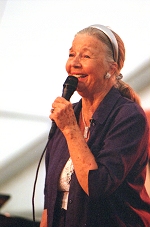| Lars Westin: Jazz in Sweden - an overview | |||
|
|
|||
|
Swing it, Professor! |
|
|
|
Swing it, Professor! By the outbreak of World War II the American swing fever was under way in
earnest in Sweden. The latest idol was an immensely popular teenager called Alice Babs (photo:
Bo Flodin) (b. 1924), who made a resounding breakthrough in 1940
with her singing in Swing it, magistern (Swing it, Professor!), a
film set in a school where the jazz music was like a breath of fresh air
compared to the stuffy, old-fashioned music education. However,
representatives of the music establishment and other conservative forces
were incensed. Alice Babs was accused of being a bad influence and even of
posing a serious threat to the younger generation. Alice Babs later worked and
recorded with Duke Ellington on several occasions (from the early 1960s
onwards), and she was even appointed hovsångerska (Singer to the
Royal Court of Sweden). By the outbreak of World War II the American swing fever was under way in
earnest in Sweden. The latest idol was an immensely popular teenager called Alice Babs (photo:
Bo Flodin) (b. 1924), who made a resounding breakthrough in 1940
with her singing in Swing it, magistern (Swing it, Professor!), a
film set in a school where the jazz music was like a breath of fresh air
compared to the stuffy, old-fashioned music education. However,
representatives of the music establishment and other conservative forces
were incensed. Alice Babs was accused of being a bad influence and even of
posing a serious threat to the younger generation. Alice Babs later worked and
recorded with Duke Ellington on several occasions (from the early 1960s
onwards), and she was even appointed hovsångerska (Singer to the
Royal Court of Sweden).Alice "Babs" Nilson, Seymours Orch: How do you do, Mr Swing (1941) from 'Swedish Jazz History Vol.4' [CAP 22040] During the war years Sweden was isolated from the rest of the world, and the import of jazz records and guest artists was effectively cut off. At the same time the entertainment business was flourishing and the demand for music was greater than ever. All this meant that Swedish jazz expanded rapidly. Jazz was played at dance venues all over the country, by orchestras large and small and by amateurs and professionals. The music of the young generation also had a considerable impact on radio and film, and there was a drastic increase in the number of domestic recordings. Inspiration still came from America, however. Isolated records that found their way over the Atlantic with convoys or were circulated in other ways, worked like vitamin injections. Short-wave transmissions were picked up, first from England and later on from the areas of Europe that were occupied by the allied troops. Some young musicians even sat by their radios with pen and paper, transcribing melodies and arrangements so as to pick up the very latest ideas from America. During this period a new jazz generation was emerging in Sweden. It included many soloists with highly personal styles, such as clarinettists Åke Hasselgård (1922-48) and Putte Wickman (1924-2006), trumpeter Rolf Ericson, alto saxophonist Ame Domnérus (b. 1924) and tenor saxophonists Carl-Henrik Norin (1920-67) and Gösta Theselius (1922-76), to name but a few. |